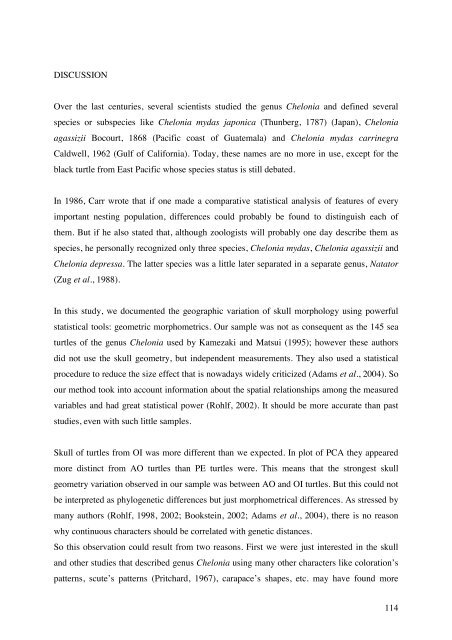étude ostéo-morphométrique des tortues marines de ... - Seaturtle.org
étude ostéo-morphométrique des tortues marines de ... - Seaturtle.org
étude ostéo-morphométrique des tortues marines de ... - Seaturtle.org
Create successful ePaper yourself
Turn your PDF publications into a flip-book with our unique Google optimized e-Paper software.
DISCUSSION<br />
Over the last centuries, several scientists studied the genus Chelonia and <strong>de</strong>fined several<br />
species or subspecies like Chelonia mydas japonica (Thunberg, 1787) (Japan), Chelonia<br />
agassizii Bocourt, 1868 (Pacific coast of Guatemala) and Chelonia mydas carrinegra<br />
Caldwell, 1962 (Gulf of California). Today, these names are no more in use, except for the<br />
black turtle from East Pacific whose species status is still <strong>de</strong>bated.<br />
In 1986, Carr wrote that if one ma<strong>de</strong> a comparative statistical analysis of features of every<br />
important nesting population, differences could probably be found to distinguish each of<br />
them. But if he also stated that, although zoologists will probably one day <strong><strong>de</strong>s</strong>cribe them as<br />
species, he personally recognized only three species, Chelonia mydas, Chelonia agassizii and<br />
Chelonia <strong>de</strong>pressa. The latter species was a little later separated in a separate genus, Natator<br />
(Zug et al., 1988).<br />
In this study, we documented the geographic variation of skull morphology using powerful<br />
statistical tools: geometric morphometrics. Our sample was not as consequent as the 145 sea<br />
turtles of the genus Chelonia used by Kamezaki and Matsui (1995); however these authors<br />
did not use the skull geometry, but in<strong>de</strong>pen<strong>de</strong>nt measurements. They also used a statistical<br />
procedure to reduce the size effect that is nowadays wi<strong>de</strong>ly criticized (Adams et al., 2004). So<br />
our method took into account information about the spatial relationships among the measured<br />
variables and had great statistical power (Rohlf, 2002). It should be more accurate than past<br />
studies, even with such little samples.<br />
Skull of turtles from OI was more different than we expected. In plot of PCA they appeared<br />
more distinct from AO turtles than PE turtles were. This means that the strongest skull<br />
geometry variation observed in our sample was between AO and OI turtles. But this could not<br />
be interpreted as phylogenetic differences but just morphometrical differences. As stressed by<br />
many authors (Rohlf, 1998, 2002; Bookstein, 2002; Adams et al., 2004), there is no reason<br />
why continuous characters should be correlated with genetic distances.<br />
So this observation could result from two reasons. First we were just interested in the skull<br />
and other studies that <strong><strong>de</strong>s</strong>cribed genus Chelonia using many other characters like coloration’s<br />
patterns, scute’s patterns (Pritchard, 1967), carapace’s shapes, etc. may have found more<br />
114















